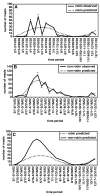Host choice and West Nile virus infection rates in blood-fed mosquitoes, including members of the Culex pipiens complex, from Memphis and Shelby County, Tennessee, 2002-2003
- PMID: 17767413
- PMCID: PMC2580743
- DOI: 10.1089/vbz.2006.0602
Host choice and West Nile virus infection rates in blood-fed mosquitoes, including members of the Culex pipiens complex, from Memphis and Shelby County, Tennessee, 2002-2003
Abstract
The source of bloodmeals in 2,082 blood-fed mosquitoes collected from February 2002 through December 2003 in Memphis and surrounding areas of Shelby County, Tennessee were determined. Members of the genus Culex and Anopheles quadrimaculatus predominated in the collections. Members of the Cx. pipiens complex and Cx. restuans were found to feed predominately upon avian hosts, though mammalian hosts made up a substantial proportion of the bloodmeals in these species. No significant difference was seen in the host class of bloodmeals in mosquitoes identified as Cx. pipiens pipiens, Cx. p. quinquefasciatus, or hybrids between these two taxa. Anopheles quadrimaculatus and Cx. erraticus fed primarily upon mammalian hosts. Three avian species (the American Robin, the Common Grackle, and the Northern Cardinal) made up the majority of avian-derived bloodmeals, with the American Robin representing the most frequently fed upon avian host. An analysis of these host feeding data using a modification of a transmission model for Eastern Equine encephalitis virus suggested that the American Robin and Common Grackle represented the most important reservoir hosts for West Nile virus. A temporal analysis of the feeding patterns of the dominant Culex species did not support a shift in feeding behavior away from robins to mammals late in the summer. However, a significant degree of temporal variation was noted in the proportion of robin-derived bloodmeals when the data were analyzed by semi-monthly periods throughout the summers of 2002 and 2003. This pattern was consistent with the hypothesis that the mosquitoes were preferentially feeding upon nesting birds.
Figures






References
-
- Anderson JF, Main AJ. Importance of vertical and horizontal transmission of West Nile virus by Culex pipiens in the northeastern United States. J Infect Dis. 2006;194:1577–1579. - PubMed
-
- Andreadis TG, Anderson JF, Vossbrinck CR, Main AJ. Epidemiology of West Nile virus in Connecticut: a five-year analysis of mosquito data 1999–2003. Vector-Borne Zoonotic Dis. 2004;4:360–378. - PubMed
-
- Apperson CS, Harrison BA, Unnasch TR, Hassan HK, et al. Host-feeding habits of Culex and other mosquitoes (Diptera: Culicidae) in the borough of Queens in New York City, with characters and techniques for identification of Culex mosquitoes. J Med Entomol. 2002;39:777–785. - PubMed
Publication types
MeSH terms
Grants and funding
LinkOut - more resources
Full Text Sources
Medical

